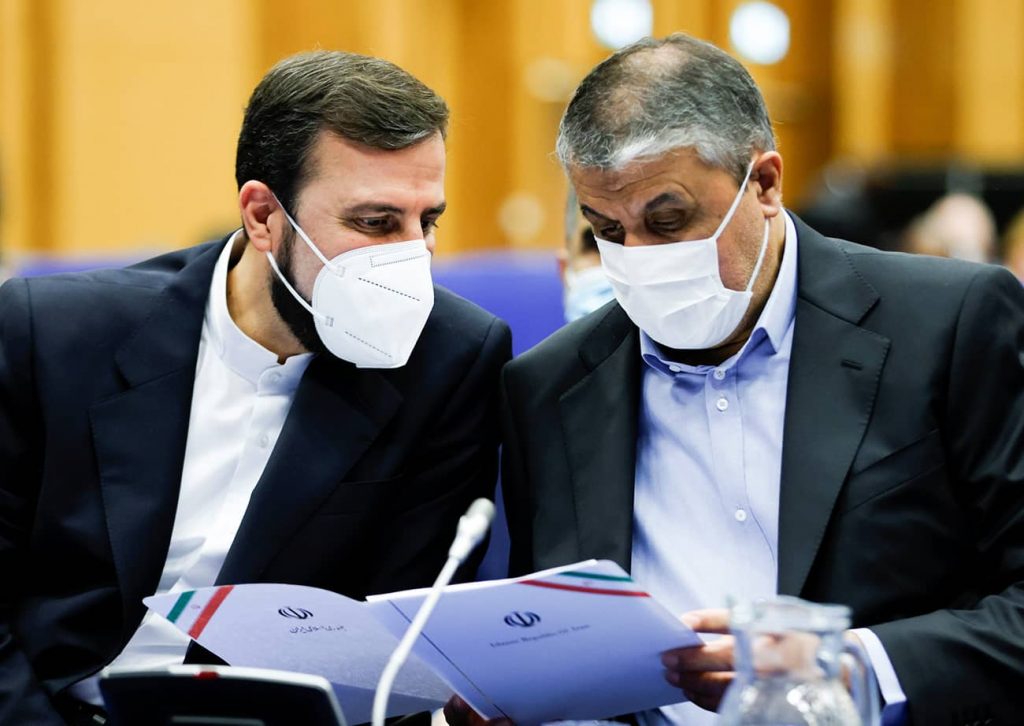A question mark now hangs over Iran’s willingness to return to compliance with the Joint Comprehensive Plan of Action (JCPOA). Indeed, following the August 27 meeting between Israel’s Prime Minister Naftali Bennett and US President Joe Biden, both referred in their public statements to the need to consider “other options” against Iran’s nuclear program, should the diplomatic course fail.
Rather than seek to reassure the West, the blunt response from Tehran amounted to an open threat. Iran’s secretary of the National Security Council, General (ret.) Ali Shamkhani, tweeted—including a version in Hebrew—a warning that this “illegal threat” against Iran gives his government the right to a “reciprocal response.”
What could Shamkhani mean and what are Iran’s options? More to the point, after all too many warnings that a breakout toward nuclear weapons may be around the corner—within weeks or a few months—is it finally for real now? I believe it is time to consider this option seriously, despite the willingness of Iran’s new government to return to the diplomatic track.
The Biden administration came to office clearly determined to reinstate the JCPOA, after Trump unilaterally withdrew from it in 2018. Trump’s decision was heartily welcomed at the time by Israel’s former prime minister, Benjamin Netanyahu, who had hoped it would curb Iran’s ambitions; yet, since then, Iran has advanced its nuclear program in many dangerous ways.
First and foremost has been Iran’s decision to enrich uranium to 60% and to build a conversion line into uranium metal—major steps that bring Iran closer than ever to the ability to acquire nuclear weapons or, at least, force the world to accept it as a threshold power (i.e., a nation that does not hold, let alone test, a nuclear weapon but is capable of it).
Despite the Biden administration’s public pursuit of a new version of the deal, Iran’s supreme leader declined to allow the former government, in the waning days of Rouhani’s presidency, to sign the agreement. True, Iran is suffering from the sanctions imposed on it, but yet, they act as if they do not feel the pressure mounting nor will they let it force them back into the JCPOA or any other similar agreement. One could argue that the reason for this is Iran’s famous bazaar culture of fierce negotiations, raising the opening bid to a higher level, or that the US is at fault, since they posited demands for changes in the agreement with which Iran could not comply. All too often in the recent past, such explanations had been put forward; this time, however, the option that Iran has, in fact, changed course and is now committed to a strategy of breaking through should seriously be considered.
To understand what makes this conclusion plausible, we should delve into a quick review of the history of Iran’s nuclear program. Despite Iran’s ongoing denials, it is very clear that it was running a broad-ranging nuclear weapons program in the 1990s and up until around 2004. Shamkhani, who now holds the position of secretary of the National Security Council, was the defense minister from 1997–2005. He was responsible at the time for the AMAD organization, whose head was Mohsen Fakhrizadeh. AMAD (previously also known as the PHRC) was responsible for designing the nuclear weapon and mounting it onto a Shahab-3 warhead. This has been proven beyond a doubt by many original documents that were published internationally in open sources and more recently by the documents from the AMAD secret archive brought over from Tehran by the Israeli Mossad. Sadly, and for several different reasons, the International Atomic Energy Agency (IAEA) did not reach any clear conclusion in writing that Iran had a nuclear weapons program, in a blunt breach of its commitments under the Treaty on the Non-Proliferation of Nuclear Weapons (NPT).
In 2003–2004, in a major shift, the leadership in Tehran changed the course of Iran’s nuclear program. It froze the AMAD project, keeping its personnel within the Defense Ministry while working on dual-use projects rather than on the direct development of nuclear weapons. In parallel, Iran’s Atomic Energy Organization (AEOI) took the lead, advancing Iran’s enrichment capabilities under the IAEA inspections and promoting Iran’s efforts on nuclear reactors. It must be clear that this change of course had to reflect a decision by the supreme leader. It was driven by the impact of events of 9/11 and the US war in Afghanistan and Iraq; it was meant to deflect Iran’s inclusion in the “axis of evil” by President Bush. Furthermore, at that same time, Iranian opposition exposed the Natanz enrichment facility, and the IAEA inspectors managed to find traces of enriched uranium in Iran. Put together, these elements endangered Iran’s national security.
Negotiations between the IAEA and Iran ensued, as did on-and-off diplomatic contacts between the international community and Iran, in an attempt to achieve a peaceful resolution of the dispute. Iran’s ongoing strategy was to deny any prior attempts or even intentions to acquire nuclear weapons and to insist (presumably based on a putative religious injunction, fatwa, by the supreme leader) that it is interested only in peaceful nuclear technology. Western diplomats had decided to adopt this convenient fiction, despite knowing that Iran was lying. They wanted to leverage this claim to convince Iran to agree to measures not included in the NPT, e.g., give up Iran’s right to enrich uranium to levels above 3.5% and agree to export any quantity of enriched uranium above 300 Kg. This could build confidence over time and then evidence could presumably be provided that Iran indeed was seeking only nuclear civilian capabilities.

The fact that the IAEA did not conclude that Iran did have a nuclear weapons program helped the negotiators to adopt their chosen course of action. It was successfully brought to an end in 2015 with the JCPOA, which put limitations on Iran’s civilian nuclear program until 2030. It took a long time to convince the supreme leader to agree to approve the agreement, given his long-standing disbelief in US goodwill and his suspicion of evil intent—a “cultural invasion”—behind any willingness to do business with the Islamic Revolution regime.
Three years later came Trump’s decision to withdraw from the agreement—without any overt proof that Iran had violated its commitments under the JCPOA. The US actually ignored other options discussed in consultations with the other signatories, i.e., Germany, UK, France (in particular), Russia, and China. This, in turn, resulted in a fatal blow to the supreme leader’s trust in any more deals with the US. The traditional hostility towards the US and other Western powers had come back to the fore, reinforcing the voices in Tehran calling to accelerate its nuclear efforts.
The new government in Tehran—led by Khamenei’s hand-picked loyalists—is now setting a new course. In terms of its policy process, Iran is very different from dictatorships such as Saddam’s Iraq or Assad’s Syria. Iran’s leader is listening carefully to his advisors, and there is always a lively discussion on strategic matters in Tehran. As mentioned above, Khamenei already changed his mind several times on the nuclear issue, responding to global and regional developments and following differing views around the decision-making table in Tehran. Since August 2021, there are now new conservative voices around the table, and the balance may have changed in favor of a confrontational approach.
The irony of history is again at full force: Iran’s decision to postpone its nuclear weapons efforts in 2004 was a result of the US decision to go into Afghanistan and Iraq. In 2021 Iran has seen the US leave Afghanistan, and Washington may soon be withdrawing its forces from Iraq, with the goal of establishing a functional democracy very far from sight. Little is left of the neocons’ once looming threat that led Tehran to wonder whether Iran may be next. It will be a fitting decision for the supreme leader in Iran to change his mind yet again regarding nuclear weapons—or at least a break to threshold status—at this sensitive time, when US presence in the region is in decline. Furthermore, the coronavirus pandemic is still prevalent and occupies the minds of all global powers. Khamenei can already judge that his major decisions—to allow enrichment to 60% and start working on enriched uranium metal—did not lead to a firm response from the international community, other than empty declarations and statements by the IAEA and the EU three.
What could be the Iranians’ next step? Could they progress even more without publicly expelling the IAEA inspectors, a step that may cause a major crisis and even lead to a military strike on their nuclear facilities? Until recently, most pundits assumed that an Iranian decision to enrich uranium to a military level of 90% would definitely be considered a casus belli. Is this still true? The latest crisis between France and the US regarding the decision to sell nuclear-propelled submarines to Australia may actually give rise to a new excuse for the ultimate level of enrichment. Many of the nuclear-powered submarines have 90% enriched uranium as their fuel. Brazil had claimed a long time ago that they would enrich uranium to that level based on their need for nuclear-powered submarines. Australia is, of course, a non-nuclear state and does not seek nuclear weapons but has now decided it does need a nuclear-propelled submarine. The Australians will surely not enrich the uranium for their submarine’s engines, but this is due to the fact they can acquire those from the US and the UK.
Iran had already publicly declared it is interested in building nuclear-propelled submarines, but this may well have been an excuse for enriching beyond the usual level for civilian usage. Iran had notified the IAEA back in 2018 it was planning to “construct naval nuclear propulsion in the future.” Clearly, now may be the time to pursue such an idea. Will the international response be blunt and unhesitating? Unfortunately, the answer is uncertain. For all the above-mentioned reasons, sadly, it may well be the case that the response will be well phrased but with no real intent to act beyond it. The previous logical step of 60% is already upon us, as noted, and has yet to evoke an effective response.
Trump’s unilateral decision in 2018 weakened the international alliance and commitment, but the Biden administration’s effort to revive the JCPOA has yet to produce the necessary unity once again. Iran may think it is free to move on and advance its program. Until now Iran did not expel the IAEA inspectors and indeed renewed its interaction with the Agency and agreed to go back to the negotiation table, but it continues to limit the inspection capabilities. The course they are taking is different from what many think tanks had war-gamed in the last decade. It is not like the North Korean path.
But will Iran now agree after all to go back into an agreement that limits its nuclear capabilities or is it possible that the decision to change course has already been taken? The negotiations will certainly keep going. It is still possible to pray that good diplomatic skills will bring Iran back into the JCPOA, or a version thereof. But it is now just as probable that the Iranians are actually “breaking out,” as Secretary Blinken declared, despite the fact it is a different “break out” than any of the experts had predicted, acquiring military-grade fissile material while still avowing that they do not seek a weapon.
It is one thing for the Israeli government to avoid an open clash—unlike its predecessor—with the US administration over the prospect of a return to the JCPOA. It is another matter, however, when it comes to preventing the emergence of a breakout situation and a regional arms race. The time for stopping Iran may be running out as we speak.



